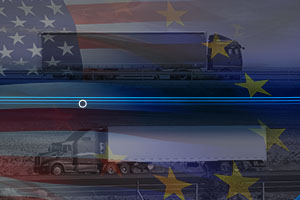
When EU and U.S. Cabotage Collide with Peak Shipping Seasons | C.H. Robinson
What is truckload cabotage, and how do EU and U.S. shippers experience these rules? Cabotage rules cover the transport of goods between two places in the same country by a transport operator from another country. When you look at EU and U.S. cabotage rules side by side, the impact on truck availability and rates is clear—especially when there are shipment surges.
Among the 28 EU countries, it’s nearly as easy to cross borders without delays as it is to drive from state to state in the U.S. Most (66%) of the EU’s total tonne-km that are transported by truck are moved by in-country hauliers. Local drivers tend to transport freight across short distances, sometimes with multiple deliveries. However, a small but growing percentage (currently 1.8%) of tonne-km is hauled within EU countries using cabotage truckload. Under the rules, a driver can carry 3 loads in 7 days within a single EU country; after that, they can either return empty to their home country or take a cross-border shipment.
Economic factors in the EU combine with cabotage to impact truckload procurement professionals:
- Cabotage makes drivers and equipment more readily available throughout Europe.
- Cabotage introduces broad EU capacity and pricing competition.
- Typically, large carriers and 3PLs obtain freight awards and then work with small carriers to fulfill their commitments. Using technology, even very small carriers can easily find freight outside their home territories, and shippers easily find carriers who prefer their lanes and product types.
- Shippers see generally stable rates.
In North America, cabotage is more restrictive. U.S. carriers can pick up a shipment in Canada and deliver it to the U.S., but they cannot travel to Canada, pick up a load in Canada, and deliver in Canada. Canadian carriers face the same restrictions within the U.S. Cabotage with Mexico is even more constrained. U.S. carriers can only pick up or deliver to a zone just inside the U.S.-Mexico border. A carrier from Mexico must take the shipment to its final delivery within Mexico. The same works in reverse when carriers from Mexico have shipments bound for U.S. delivery.
When cabotage; active truck utilization (recently at 98.3%, according to FTR); shifting exchange rates between the U.S. and Canada; and peak seasons converge, U.S. truckload procurement professionals experience the situation this way:
- Cabotage has significant limitations between the U.S., Canada, and Mexico.
- U.S. shippers do not have ready access to carriers and equipment from other countries to assist with temporary demand surges.
The bottom line is, there is no one-size-fits-all, when it comes to truckload procurement between North America and the European Union. The best thing you can do is learn what’s similar and different between these two busy trade regions, then adapt your approach to fit each market. To learn more, see our new, two-part white paper series, “Improving EU and U.S. Truckload Procurement.” Part 1 offers 7 insights on carriers and drivers; Part 2 has 6 insights on route guides and peak seasons.



